8th March 2022
InMind: The Rise of Real Women

Mindshare’s InMind report series helps brands keep the latest growthopportunities on media, consumers and markets in mind.
Traditionally, media has played a significant role in reflecting the state of society. Today, however, the role of media has greatly expanded; it is no longer a mere reflection of society, but rather a key shaper of trends and cultural shifts. In recognition of this year’s International Women’s Day, Mindshare China’s InMind series explores the rapid evolution of female portrayal in media. In doing so, InMind shares a point of view on ensuring positive and authentic female representation in the media, as well as how this representation can best advocate for individuality and equality. Brands that are able to navigate this will not only craft content that resonates but also ensure the creation of personalized brand relationships.
The Challenge
Chinese women are making remarkable strides in their social position and market power, with the #Sheconomy contributing to 75% of total household consumption in 2021[1]. As such, it is no wonder that women have become the most targeted cohort in advertising and communications. Yet with every brand or business scrambling to capture the attention of this cohort, generalizations of women in the media have arisen.
In fact, 41% of women in China believe “ads are a waste of time.”[2]Putting numbers into perspective: that’s 284 million Chinese women[3] who are impervious to targeted marketing efforts - almost the same as the total population of Indonesia[4]. Despite this view, 60% acknowledge that “ads can still influence their choice in brands.”[5]
These findings suggest that while marketing towards women has evolved past the historical generic profiling of “mothers living in Tier 1 cities with interest in yoga”, agencies and brands alike need to be cautious not to simply revert to #ShePower taglines as a pink communication thread for all.
In truth, women today are becoming increasingly confident in living out their individual identities, with the single connecting thread being the 81% of women who agree that “Beauty is asserting personality and difference from within.”[6]
Real Women Leading Change
In recent years, the media has played an increasingly instrumental role in the empowerment of women in society. While themes of she-can and she-should are representative of progress made in broader society, the reality is there has never been more focus on women in the media than there is today. Below, we dive into some examples of content that is leading the way in crafting genuine and representative connections with female audiences.
In 2020, Sisters Who Make Waves (乘风破浪的姐姐) triggered literal waves of discussion on social media around stereotypes of #LeftoverWomen and Single Cats – i.e. single, independent women who do not desire a relationship. Similarly, a month following Sisters’ release, Nothing But Thirty (三十而已) came under the spotlight for breaking stereotypes against women in their 30s, amassing 7.5 billion views on Tencent Video.[7]
In 2021, brands took on a more proactive role in encouraging women to #BeYourself, nudging women to break gender biases and to take ownership of their lives. In doing so, they shifted from a she-can attitude towards a she-should attitude. In the first half of 2021, viewers saw the release of Hi, Mom (你好, 李焕英) and Sister (我的姐姐) sparking conversations around gender preference and the changing dynamics of a woman’s role in the family. Hi, Mom quickly became the talk of the town, becoming the second highest grossing film in China's box office history.[8]
Leading up to 2022, we witnessed B for Busy (爱情神话), a story set in metropolitan Shanghai, gaining immense popularity despite receiving polarising reviews. The film aimed to capture love, relationships, and friendships amongst middle-aged women and men in their most authentic form and environment, with the entire film spoken in Shanghainese dialect. As Shao Yihui, the director of B, best attests to her vision, “I don't think a film for women has to have a powerful woman protagonist, I don't want women to be an object of the gaze."
The development and coverage of women in China’s media has not been limited to film and TV, however. Sports, and in particular the Beijing Olympics, has also provided a key opportunity to drive female empowerment at a time when 72% of women in China are actively taking a public stance on gender equality.
On February 6th, we witnessed the dramatic triumph of the Steel Roses (China’s women’s national football team) at the AFC Women’s Asian Cup. Following their win, the topic #PayRiseForWomenFootballPlayers (#给女足加钱) gained over 100 million views on Weibo in support for equal pay in football, an industry long-considered to have a gender wage gap.[9]
During the 2022 Beijing Winter Olympics, Eileen Gu, an American-born athlete who decided to represent China at the games, became a household name overnight following her first-ever double cork 1620 that led to her Gold win at the games. #EileenGuGoldMedalist (#谷爱凌金牌) amassed more than 300 million views within just one hour[10]– eventually causing Weibo to crash.
Despite achieving the ultimate accolade of being affectionately named ‘Beijing’s Daughter’ (“北京大妞”), for Chinese women, Gu stood for something beyond her sparkling title. Gu recalled going into her final run, “Even if I didn’t land, I felt I could use this platform [the Winter Olympics] to send a message out to the world and hopefully encourage more girls to break their own boundaries.”
Gu offered a voice to current and aspiring female athletes and women alike, encouraging them to break free from self-imposed limits to become their best selves, regardless of the view of the wider public.
Two Takeaways for Brands
Authenticity is Key
As demonstrated in films like B for Busy, as well as the triumphs of the Steel Roses and Eileen Gu, women don’t need to have a narrative imposed on them. Rather, they desire a fair and just platform to tell their own authentic stories.
A simple yet effective way for brands to market to women is by letting women tell her personal story, rather than using it solely for the brand purpose. Moving forward, media should serve as a looking glass to provide a platform and documentation to the social changes happening around real women and men.
Personalization over Generalization
Today it is easy for brands to fall into the trap of identifying all females as alike, leading to broad generalisations. Instead, brands should move beyond she-should and she-can to she-is, focusing on the intersection between identity and experiences across different life stages. Every woman walks her own path in her own time. By developing true insights, recognizing the diversity of individual experiences, and recognizing that when marketing to women: one size does not fit all, brands will achieve authentic, personal brand relationships. To do so,brands need to talk with real women in addition to analyzing their purchase behavior as a proxy to knowing them.
And let us not forget, today is a day to reflect on progress made, to celebrate the acts of courage and determination by our mothers, sisters, partners, friends, and colleagues who are playing a profound role in shaping history for the next generation of females to live out their true authentic lives – unshaped by their gender.
Happy International Women’s Day!
Sources:
[1] China National Residents Survey (CNRS), 2021
[2] Ibid.
[3] Estimated population size, National Bureau of Statistics of China, 2021
[4] World Meters,, 2021
[5] CNRS, 2021
[6] Ibid.
[7] Maoyan Pro, 2022
[8] Ibid.
[9] Weibo Hot Topic, 2022
[10] Ibid

To learn more about Mindshare China, scan the QR code and follow our official WeChat account.